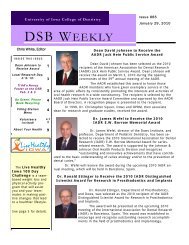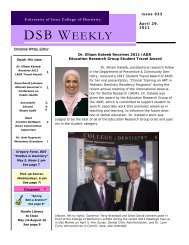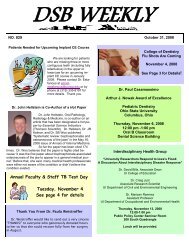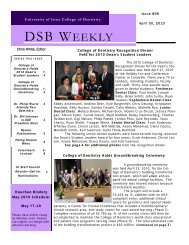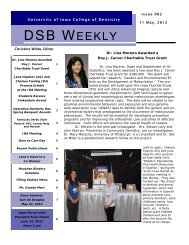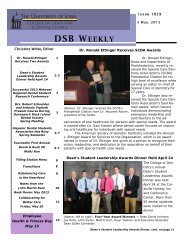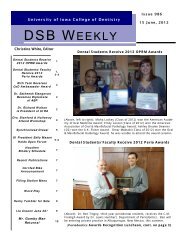Iowa Section of AADR - The University of Iowa College of Dentistry
Iowa Section of AADR - The University of Iowa College of Dentistry
Iowa Section of AADR - The University of Iowa College of Dentistry
You also want an ePaper? Increase the reach of your titles
YUMPU automatically turns print PDFs into web optimized ePapers that Google loves.
phenotypes are currently being evaluated and will be presented.<br />
Supported by: CDC grant 5R01DD000295; R03-AR055313; NIDCR Training Grant T32 DE014678-09<br />
3. HBD3-enhanced Porphyromonas gingivalis rHagB Cytokine Responses in Dendritic Cells<br />
L. Harvey 1 , K.A. Brogden 1 , A. Progulske-Fox 6<br />
1 <strong>University</strong> <strong>of</strong> <strong>Iowa</strong>; 6 <strong>University</strong> <strong>of</strong> Florida, Gainesville, FL<br />
Previously, we found that HBD3, co-administered with recombinant hemagglutinin B (rHagB) attenuates a<br />
Porphyromonas gingivalis rHagB in human myeloid dendritic<br />
cells.<br />
Objectives: <strong>The</strong> objective <strong>of</strong> this study was to determine if the chemokine and cytokine response <strong>of</strong> dendritic cells<br />
induced by rHagB is still attenuated when HBD3 is administered prior to exposure with rHagB; when administered<br />
simultaneously with rHagB; or when administered after exposure to rHagB.<br />
Methods:<br />
post exposure, culture supernatants were removed for the determination <strong>of</strong> 22 chemokines and cytokines using<br />
Instrument (Luminex, Austin, TX).<br />
Results: rHagB alone induced a robust chemokine and cytokine response. <strong>The</strong> timing <strong>of</strong> HBD3 administration<br />
was important. HBD3 co-incubated with rHagB (for 30 min prior to exposure) attenuated a chemokine and<br />
simultaneously, but not together or if HBD3 was administered 1 hour after, then rHagB induces a modestly robust<br />
Conclusions: <strong>The</strong> results show that the timing <strong>of</strong> HBD3 administration is important and HBD3 has the capacity to<br />
modulate the cytokine and chemokine response <strong>of</strong> dendritic cells to rHagB. Supported by funds from NIH, NIDCR<br />
R01 DEO14390.<br />
10<br />
Supported by: <strong>University</strong> <strong>of</strong> <strong>Iowa</strong>, <strong>College</strong> <strong>of</strong> <strong>Dentistry</strong>, <strong>Iowa</strong> Dental Research Grant<br />
4. HBD3 Inhibits Porphyromonas gingivalis rHagB Binding to Dendritic Cells<br />
J. Van Hemert 5 , E. Recker 5 , K. Walters 2 , A. Progulske-Fox 6 , K.A. Brogden 5<br />
2 5 6 <strong>University</strong> <strong>of</strong> <strong>Iowa</strong>, <strong>Iowa</strong> City, IA; <strong>University</strong> <strong>of</strong> <strong>Iowa</strong> <strong>College</strong> <strong>of</strong> <strong>Dentistry</strong>, <strong>Iowa</strong> City, IA; <strong>University</strong> <strong>of</strong> Florida,<br />
Gainesville, FL<br />
Human β-defensin 3 (HBD3) is a small, well-characterized peptide with broad antimicrobial activities and<br />
diverse innate immune functions. Previously, we found that HBD3 binds to recombinant Porphyromonas gingivalis<br />
dendritic cells.<br />
Objectives: Our objective was to determine if HBD3 binding to rHagB alters the binding <strong>of</strong> rHagB to the surface <strong>of</strong><br />
human myeloid dendritic cells.<br />
Methods: To test this, human myeloid dendritic cells and mouse JAWS II cells were incubated with 0.1 μM<br />
rHagB, 1.0 μM HBD3+0.1 μM rHagB (10:1 molar ratio), 1.0 μM HBD3, or 0.1 M PBS, pH 7.2. After 5 minutes,<br />
with monoclonal MoAb 1858 to rHagB, polyclonal rabbit to rHagB, and polyclonal 500-P241 rabbit antibody to<br />
microscopy.<br />
Results: For confocal microscopy, 6.3 x 104 dendritic cells in chamber slides were incubated with rHagB and had<br />
Conclusion: Overall, these results strongly suggest that HBD3 binding to rHagB alters the binding <strong>of</strong> rHagB to the<br />
response <strong>of</strong> rHagB in dendritic cells. This work was supported by NIH, NIDCR grant R01 DEO14390.<br />
Supported by: NIH, NIDCR grant R01 DEO14390.<br />
11



